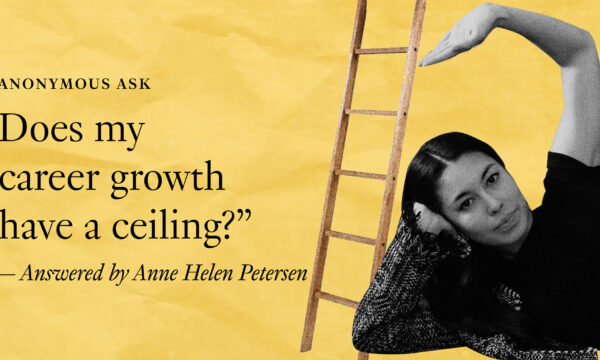
Shop This Look
Career Confessions: 10 Women on How They’ve Been Using AI at Work
Working women tell us how they’re using ChatGPT and other AI-powered tools at the office—and in secret.
Ask ChatGPT to, “Write an introductory paragraph for an article spotlighting how people are using AI tools at work,” and it might give you this:
From streamlining complex processes to enhancing decision-making through data-driven insights, AI’s pervasive influence is empowering professionals across diverse sectors. This article delves into the dynamic realm of AI in the workplace, shedding light on the ingenious ways individuals and teams harness these technological advancements to boost productivity, unlock innovation, and navigate the intricate demands of today’s professional world.
If you’ve spent any time playing around with ChatGPT, the most widely known LLM (large language model), you probably aren’t surprised by this subpar product. Creative writing is not its strong suit. Sure, it can fill a page within seconds, and the results are usually grammatically correct, but you can expect the tone to be a cringey mix of robotic, cheesy, and wholly unimaginative. Needless to say, I won’t be relying on generative AI—outside of the occasional brainstorm or styling experiment—anytime soon.
That said, we all already use some form of artificial intelligence on a daily basis. Computers and other automated technologies have existed for decades, after all. But in the last year, there’s been a shift in the landscape. We now regularly wake up to news of rapidly advancing technologies that threaten our jobs and promise to transform the global workforce. These recently developed tools may not currently play a significant role in my own work, but I know millions of people are using them to their advantage on a daily basis—a fact that should not be ignored.
If we expect society to use AI ethically, we all have a responsibility to understand it on a basic level. Maybe you’re not ready to experiment with AI yourself, but you can learn a lot about it through the experiences of others. Doing so might even alleviate some of your AI anxiety; these tools have limits. That’s why I set out to ask working women how they’ve been using AI at work—whether openly or in secret. Their anonymous answers below.
Want more M Dash?
Sign up for our weekly newsletter.
Thank you!
Open to Experiment
Product management executive in tech
“As a technologist and product management leader, it’s part of my DNA to keep a pulse on emerging tech. I was surprised at how fast chatbots like ChatGPT and Google Bard caught fire, because LLMs have been used quietly at many top tech companies for years.
Over the past six months or so, I’ve been using both of these tools to research a variety of items, such as best practices for building a data warehouse, advice for developing an API (application programming interface), and key performance metrics for APIs. These tools have probably reduced my research time (not my overall workload!) by 50%. I also actively use Grammarly, an AI-based spell-checking and editing tool, and I do think it’s improved my writing. My presentations, emails, and chats are clearer, more succinct, and more effective.
I’ve even ventured to use AI image generators to create headshots for my LinkedIn profile, which was a total bust. They all produced headshots that didn’t look like me, were unsettlingly ‘off’-feeling, and altered my appearance to make me look more non-Asian.”
Having Fun with Puns
Copywriter at an advertising agency
“I’ve been using ChatGPT to come up with punny email headlines. Our account team is constantly amazed that I somehow ‘never run out of puns.’ However, it hasn’t lessened my workload to any noticeable degree, because its responses are only usable about half of the time, and when they are promising, I still make major tweaks. Oftentimes, I’ll also have to feed it a secondary prompt before I get a workable product. ChatGPT is far from revolutionary in my mind, but it can be a useful tool when you’re feeling stuck as a writer.”
“As much as we embrace AI technologies, we also understand the importance of human touch and judgment. Our goal is to ensure that our AI tools maintain a symbiotic relationship with human intelligence.”
Forecasting Faster
Specialist in the furniture industry
“In my line of work, AI has been instrumental in streamlining processes and enhancing the effectiveness of our services, specifically when it comes to sales forecasting and consumer behavior predictions. For instance, we use predictive analysis software to forecast demand based on seasonality, weather patterns, and consumer buying behavior. This helps us to optimize stock levels and prevent costly surpluses or shortages of products.
The benefits of using AI-powered tools have been tangible in my work. AI has undoubtedly reduced my workload and significantly improved process efficiency, especially in areas like customer service and demand forecasting. By automating repetitive tasks, my team and I have more time to focus on designing new products, improving existing offerings, building customer relationships, and formulating strategic business decisions. I even think the final products and services we deliver now are of higher quality, thanks to the predictive analytics that allow us to understand and cater to our target market more proactively and precisely.
At the same time, as much as we embrace AI technologies, we also understand the importance of human touch and judgment. Our goal is to ensure that our AI tools maintain a symbiotic relationship with human intelligence.”
Eliminating Language Barriers
Travel blogger
“My primary AI tool is Google Analytics. It provides real-time insights on large amounts of data—helping to identify traffic sources and effective content. This has significantly reduced the time I spend on analytical tasks, which leaves me with more room for content creation and strategic planning.
I’ve also embraced AI-powered translation tools to better connect with my international audience. These instruments have markedly improved the engagement of non-English-speaking visitors and have led to more effective communication and connection with my global community.”
“There was something less overwhelming about being able to look at a finite list of 10 resources in my area—complete with a little blurb about each organization’s unique value proposition.”
Brainstorming Better
Social worker in hospice care
“I really enjoy using ChatGPT to help me think creatively when my mind feels fried after a long day. Most recently, I used it to help me come up with resources for the homeless that I could share with the family member of a client I was working with. Essentially, it felt like doing a Google search, but there was something less overwhelming about being able to look at a finite list of 10 resources in my area—complete with a little blurb about each organization’s unique value proposition. I’ve also been using ChatGPT to help me think of digital products that I can make for social workers as a way to earn a bit of passive income on the side.
Although I find ChatGPT a useful tool, I wouldn’t say my workload is reduced. I hesitate to enter names and other protected health information, so ultimately, my most time-consuming tasks as a social worker (e.g. clinical documentation) still have to be done 100% by me. I also do a great deal of work by telephone, and as much as I’d like a robot to handle my calls, that is still very much a human-driven task that AI can’t help me with anytime soon.
Ultimately, my job requires empathy and compassion, in addition to critical thinking and
problem-solving. I find that when I get the most accolades for my performance, it comes from families appreciating the connection we’ve built—not so much from my logical problem-solving skills.”
Bigger Fish to Fry
eCommerce Manager at a printing company
“I use a range of AI-based tools for my job, including Google Analytics and Piwik, which I use to track things like engagement and click-through rates.
We’ve also been using Adobe Firefly for product mock-ups on our website so that customers can see and feel what their print may look like in a setting relevant to their industry. For example, we could use it to mock up a menu on a restaurant background or a flag at a music festival. It means I’m spending less time creating artwork from scratch, and we’re also able to create templates for our online design tool much faster.
Because of ChatGPT, I no longer have to rely on our content writer to draft copy, so they can get onto bigger tasks at hand. Interestingly enough, we’re now using AI to assess and gauge the authenticity and human tone of our content. It’s quite ironic, but it allows us to ensure that our work strikes the right balance between AI-driven efficiency and genuine human touch.”
“Our company actually developed its own version of ChatGPT, as we aren’t allowed to use public versions due to data confidentiality concerns.”
Not Quite Convinced
Medical researcher
“Our company actually developed its own version of ChatGPT, as we aren’t allowed to use public versions due to data confidentiality concerns. I’ve tried to use it for organization announcements, and while the grammar is always correct, the tone just sounds artificial. Sometimes I might use a phrase or two that it writes, but even in those cases, I edit and embellish its product, oftentimes to the point that it’s all my original writing in the end.”
Improving Presentations
Chief of Staff at a marketing consultancy
“I’ve used ChatGPT to research content for keynote speaking engagements and to quickly educate myself on new categories and clients. I’ve also created custom graphics for presentations in MidJourney and frequently use Canva’s AI-powered doc-to-deck feature that takes an outline and transforms it into slides.
Since I work at the intersection of tech and creativity, I was an early adopter—or at least explorer—of generative AI, although I have a lot of concerns about the ethics of how LLMs are trained and how companies are currently using it. I’m also concerned about the potential impact on kids growing up in this new era of AI and am even hoping to host a meet-up at SXSW to discuss this with other parents in tech.”
“Ever since ChatGPT became global news, I received clear instructions from my company not to seek its help in generating content. Of course, I abided by this rule, but I did use ChatGPT to help simplify complex pieces of information so that I could understand them better and write about them effectively.”
Embracing the Gray Area
Content marketer
“I work in the digital marketing industry and have spent the last six months working as a content writer. Ever since ChatGPT became global news, I received clear instructions from my company not to seek its help in generating content. Of course, I abided by this rule, but I did use ChatGPT to help simplify complex pieces of information so that I could understand them better and write about them effectively.
Another way I use ChatGPT is by asking it to generate subheading ideas for a specific topic. This has helped me plan an all-encompassing content outline, since it suggests topics that I don’t initially think to include in my articles.”
An In-Pocket Personal Assistant
Editor at an LLC advisory firm
“I use Google Assistant daily as a way to better manage my busy schedule. Using voice commands, I can schedule meetings, set reminders, and constantly update my calendar. This hands-free approach enhances my productivity, allows me to multitask more effectively, and improves my overall connectedness. Another helpful feature of Google Assistant is the translation tool, which helps me quickly translate conversations with multilingual clients. The privacy considerations Google Assistant provides are a huge bonus!”










